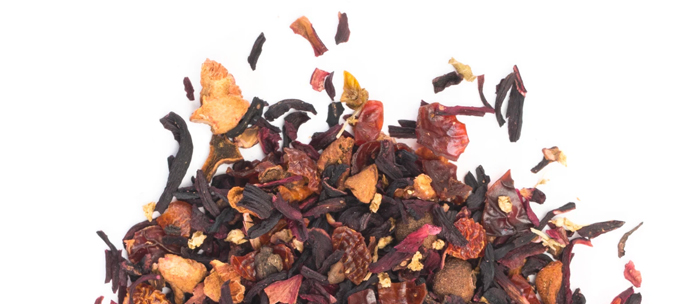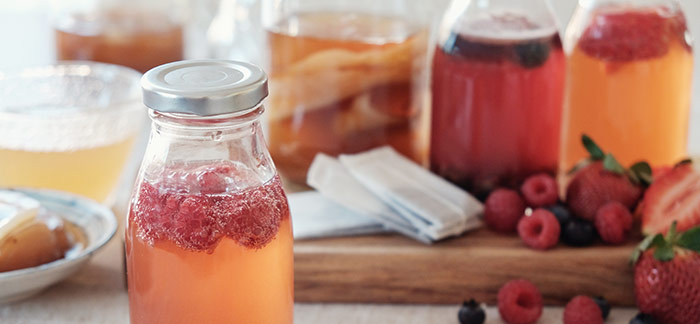|
Faithful tea lovers will testify that not only is the art of tea drinking therapeutic but that the health benefits are endless. One such tea is Kombucha, either home brewed or commercially bought, it’s a fermented tea that is packed full of probiotics, amino acids and various vitamins that help keep your digestive system in sync.
So, how do you make this potent immune boosting blend that origins started in mystical China and soon cemented its popularity along the Silk Road?
We suggest you start simple and then venture into more creative flavours’ and concoctions once you’ve mastered the basics. Below is our suggested recipe to get you started, but before we get into the specific’s, Kombucha the world over requires what is called a SCOBY, in other words a Symbiotic Culture of Bacteria and Yeasts. The purpose of the SCOBY is to eat the sugar and caffeine in the tea and metabolize it to produce all sorts of health benefits like probiotics, vitamins and amino acids. Its health properties are particularly impressive, but beware it looks rather slimy and scary! Either acquire ‘a baby’ from a friend, buy one at a health shop or grow your own.
|
| 1. Basic Kombucha: |
 |
|
Ingredients:
- SCOBY
- 24 cups of filtered water
- 1 1/4 cups organic cane sugar
- 6 organic and natural tea bags (green, black or rooibos work well)
- 1 cup already brewed kombucha (you can get this at most health shops)
Supplies:
- 1 large glass jar (do not use any metal in this process, it will kill the healthy bacteria)
- 1 dish towel
- 1 elastic band or piece of string
- empty glass bottles (amount will depend on size of bottles)
|
Instructions
- Clean out your glass container so there is no possibility of remaining bacteria.
- Boil 24 cups of water in a large pot and once boiling, turn off heat and add tea bags.
- Steep until water has reached room temperature.
- Remove tea bags and add SCOBY, 1 cup of kombucha, cane sugar, and steeped tea to jar.
- Cover with a dish towel and secure in place with string or an elastic band.
- Store in a cool, dark place for 10 days. Do not touch at all.
- After 10 days, remove dish towel and divide kombucha between jars, leaving 1 inch of space between kombucha and lid in each jar.
- Your kombucha is ready! Drink and enjoy! (Store in fridge for up to several months).
|
|
 |
| 2. Rose hip and Hibiscus Kombucha: |
|
This is one of our firm favourites as the added benefits of herbs such as elderberries, used for boosting the immune system, hibiscus recognised for its calming effects on the nervous system and rose hips as a source of vitamin C are just too good to ignore.
|
 |
|
Instructions
- Add 1 Tbsp of above herbs to a to four litres of water and bring to a boil.
- Add your chosen tea, put on the lid, turn off the heat and let the tea steep for 10 minutes.
- Remove both the herbs and the tea. Continue with your normal kombucha brewing routine.
|
|
 |
| 3. Can't give up that caffeine fix? Then try coffee kombucha: |
|
Be careful not to heat this brew as it will kill off all the good bacteria. The good news is with this recipe, there is no need to decide between coffee or kombucha.
|
 |
|
Ingredients:
- 2 quarts freshly brewed plain coffee
- 1/2 cup sugar
- SCOBY
|
Instructions
- In a glass container, dissolve the sugar in the hot coffee and allow the mixture to cool to room temperature. Be sure the coffee is free of leftover coffee grounds.
- Add the kombucha scoby and cover the jar with a tight-weave cloth or coffee filter, secured with a tight rubber band.
- Ferment undisturbed at room temperature out of direct sunlight for at least 7 days. After 7 days, start tasting the kombucha daily using a straw. Halt the process when the kombucha coffee tastes pleasant to you.
|
|
|
Now that you have the hang of it, it’s time to get creative with flavours. All that is required is an additional 1-2 days of fermenting (known as the second fermentation) and roughly a 5 cm space between the kombucha mixture and the lid.
|
|
Some great mixes include:
|
- Grapefruit – add ¼ cup freshly squeezed grapefruit juice.
- Blueberry – add ½ cup mashed blueberries.
- Pineapple & basil – Add ½ cup chopped pineapple with ¼ cup chopped basil leaves.
- Raspberry, lemon, ginger – Add ½ cup raspberries, the juice of 1 lemon and 1 cm fresh ginger, grated.
- Dried fruit such as cranberries, goji berries, dates and figs are good, but avoid raisins or anything that contains sulphur dioxide as it can cause a rotten egg smell!
- Herbs such as lavender and lemon balm can be used by themselves, or in combination with a fruit such as apple and mint, strawberries and thyme, raspberries and basil.
- Mild spices in moderation either singly or in a blend, or to complement a fruit, including: turmeric, allspice, cardamom, cinnamon, coriander, cloves, ginger, star anise, peppercorn, juniper and liquorice. Or hot spices such as cayenne or jalapeño make a fiery potion to ward off flu season.
- Vegetables such as beetroot, carrot or cucumber are great for savory flavour. Garlic can be great to give a kick to something else, or it goes well with lemon.
|
|
In simple terms: Kombucha is an amazing source of probiotics for your gut. Healthy gut, healthy immune system, healthy human. After all that effort the final kombucha drink will contains vitamin C, vitamins B6 and B12 thiamin, acetic acid, and lactic acid, as well as small amounts of sugar and ethanol, depending on the length of fermentation. With all these vitamins packed into one slow brewed cup, there is simply no excuse not to try it yourself!
|
|

